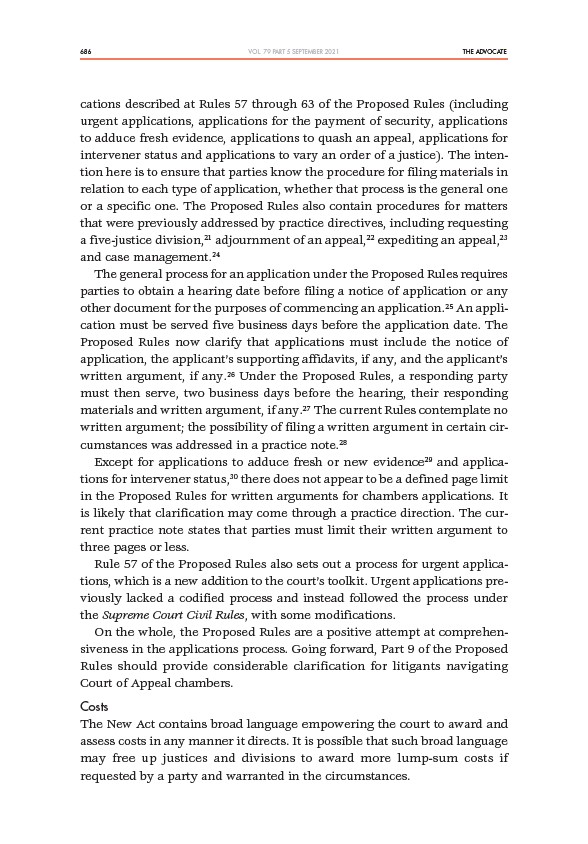
686 THE ADVOCATE
VOL. 79 PART 5 SEPTEMBER 2021
cations described at Rules 57 through 63 of the Proposed Rules (including
urgent applications, applications for the payment of security, applications
to adduce fresh evidence, applications to quash an appeal, applications for
intervener status and applications to vary an order of a justice). The intention
here is to ensure that parties know the procedure for filing materials in
relation to each type of application, whether that process is the general one
or a specific one. The Proposed Rules also contain procedures for matters
that were previously addressed by practice directives, including requesting
a five-justice division,21 adjournment of an appeal,22 expediting an appeal,23
and case management.24
The general process for an application under the Proposed Rules requires
parties to obtain a hearing date before filing a notice of application or any
other document for the purposes of commencing an application.25 An application
must be served five business days before the application date. The
Proposed Rules now clarify that applications must include the notice of
application, the applicant’s supporting affidavits, if any, and the applicant’s
written argument, if any.26 Under the Proposed Rules, a responding party
must then serve, two business days before the hearing, their responding
materials and written argument, if any.27 The current Rules contemplate no
written argument; the possibility of filing a written argument in certain circumstances
was addressed in a practice note.28
Except for applications to adduce fresh or new evidence29 and applications
for intervener status,30 there does not appear to be a defined page limit
in the Proposed Rules for written arguments for chambers applications. It
is likely that clarification may come through a practice direction. The current
practice note states that parties must limit their written argument to
three pages or less.
Rule 57 of the Proposed Rules also sets out a process for urgent applications,
which is a new addition to the court’s toolkit. Urgent applications previously
lacked a codified process and instead followed the process under
the Supreme Court Civil Rules, with some modifications.
On the whole, the Proposed Rules are a positive attempt at comprehensiveness
in the applications process. Going forward, Part 9 of the Proposed
Rules should provide considerable clarification for litigants navigating
Court of Appeal chambers.
Costs
The New Act contains broad language empowering the court to award and
assess costs in any manner it directs. It is possible that such broad language
may free up justices and divisions to award more lump-sum costs if
requested by a party and warranted in the circumstances.